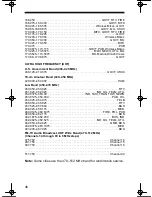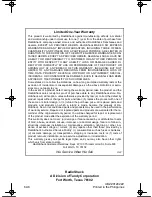
42
To find the birdies in your particular scanner, begin by disconnecting the
antenna and moving it away from the scanner. Make sure that no other
nearby radios or TVs are turned on near the scanner. Use the search
function to search every frequency range from its lowest to the highest
frequency. Occasionally, the searching will stop as if it had found a sig-
nal, often without any sound. That is a birdie. Make a list of all the birdies
in your scanner for future reference.
GUIDE TO THE ACTION BANDS
Typical Band Usage
VHF Band
Low Range
29.00–50.00 MHz
6-Meter Amateur
50.00–54.00 MHz
U.S. Government
137.00–144.00 MHz
2-Meter Amateur
144.00–148.00 MHz
High Range
148.00–174.00 MHz
UHF Band
U.S. Government
406.00–420.00 MHz
70-cm Amateur
420.00–450.00 MHz
Low Range
450.00–470.00 MHz
FM-TV Audio Broadcast, Wide Band
470.00–512.00 MHz
Public Service
806.00–823.93 MHz
Conventional Systems
851.00–856.00 MHz
Conventional/Trunked Systems
856.00–861.00 MHz
Trunked Systems
861.00–866.00 MHz
Public Safety
866.00–868.93 MHz
High Range
896.11–902.00 MHz
33-Centimeter Amateur
902.00–928.00 MHz
Private Trunked
935.00–940.00 MHz
General Trunked
940.00–941.00 MHz
Fixed Services
941.00–944.00 MHz
Studio-to-Transmitter Broadcast Links
944.00–952.00 MHz
Private Fixed Services, Paging
952.00–956.00 MHz
20-513.fm Page 42 Wednesday, August 4, 1999 2:39 PM











































